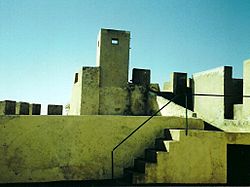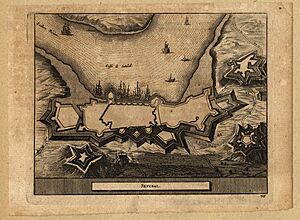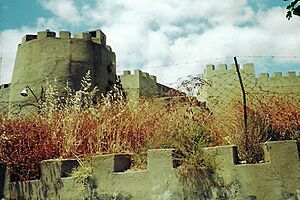Castle of Almada facts for kids
Quick facts for kids Castle of Almada |
|
|---|---|
| Castelo de Almada | |
| Setúbal, Península de Setúbal, Lisbon in Portugal | |

A view of the tower and battlements of the Castle of Almada
|
|
| Coordinates | 38°41′5.03″N 9°9′20.8″W / 38.6847306°N 9.155778°W |
| Type | Castle |
| Site information | |
| Owner | Portuguese Republic |
| Open to the public |
Public |
| Site history | |
| Materials | Stone, Granite, Iron, Wood |
The Castle of Almada (in Portuguese: Castelo de Almada) is an old medieval castle. You can find it in the area of Almada, Cova da Piedade, Pragal e Cacilhas, within the Almada municipality in Portugal. This castle stands in a very important spot, looking over the Tagus River.
Contents
A Look Back: History of Almada Castle
Early Beginnings and Muslim Rule
The castle was built in a very smart location. Long ago, Muslim forces lived here during their time in the Iberian Peninsula. They called the place al-Madan. This name might mean "gold mine" or "silver mine." It suggests that people once dug for minerals in this area. An old book from the 12th century, called Geografia Nubiense, mentions this place.
Reconquista and Portuguese Control
Around 1147, during the Reconquista (when Christian kingdoms took back land from Muslim rule), Lisbon was attacked. Almada was also captured by King D. Afonso and his crusader army. After it was taken, the town's defenses were made stronger. This happened after a special document, called a foral (a royal charter), was given in 1170.
King D. Sancho I signed a new foral in 1190. But then, forces from the Almohad Caliphate attacked. They were led by caliph Abū Yūssuf Yaʿqūb bin Yūssuf al-Manṣūr. They took over areas in the south and destroyed Almada's defenses in 1191. The Portuguese king took back the castle in 1195. He then started building a new castle there.
A big turning point was the Battle of Navas de Tolosa in 1212. Christian forces won a major victory against Muslim forces. After this, the lost lands, from the Tagus River to Évora, were taken back.
Changes Over the Centuries
On February 24, 1255, King D. Afonso III confirmed that the Order of Santiago would control several castles. These included Almada Castle. The castle was made bigger and stronger during the time of King D. Dinis I. Later, King Ferdinand (1367-1383) also worked on its defenses.
During a time of trouble for Portugal (1383-1385), Lisbon was under attack. Almada was also surrounded by forces loyal to Castile. A famous Portuguese general, D. Nuno Álvares Pereira, tried to free the area but couldn't.
King D. Manuel I (1495-1521) added a new tower to the south wall of the castle.
Defending Lisbon and Later Uses
During the Portuguese Restoration War (1640-1668), the old castle helped defend the town. It was rebuilt to protect Lisbon. New strongholds, called bastions, were added.
The castle was damaged by the big Lisbon earthquake on November 1, 1755. It was rebuilt around 1760. This is when it got its current size and shape.
The castle stopped being a military fort in 1825. Its weapons were moved to Lisbon. But it was used again in 1831 during the Portuguese Civil War (1828-1834). King D. Miguel visited it in 1832. In 1833, his forces were defeated near Lisbon. They retreated to Almada Castle but were defeated again the next day.
Between 1865 and 1866, repairs were done. This helped the castle work with other defenses along the Tagus River. As its military role lessened, its soldiers were reduced. In 1868, a public garden was opened at the castle. It offered great views of the Tagus River.
When Portugal became a Republic on October 5, 1910, Republicans took over the castle without a fight.
During the 1918 pandemic, the castle was used as a temporary hospital.
Modern Times and New Uses
In 1931, during a revolt, a pilot tried to bomb the castle. His bomb missed and fell in the town square. This caused harm to people nearby, including children. The square was later renamed Largo das Vitimas (Square of the Victims). A plaque marks this sad event.
During the Second World War, the castle received new artillery. It had soldiers stationed there until the Carnation Revolution in 1974. After 1976, the Guarda Nacional Republicana (GNR), Portugal's national guard, started using the castle. The building was rebuilt for their use.
In the 1990s, the Almada city council improved the public garden. This was part of restoring the old town center.
Today, the castle and its defenses are used by a part of the GNR.
See also
 In Spanish: Castillo de Almada para niños
In Spanish: Castillo de Almada para niños






